And why you should care…
By Leif Johnson – Conservancy of Southwest Florida Biologist:
93 million miles in 8 minutes.
That is the distance from the earth to the sun and the time it takes for light energy from the sun to reach the earth’s surface. As the world rolls on its axis, it brings the blue light of dawn ever closer to a sleeping Florida. The torrent of light rips through the atmosphere, plunging into the vast Atlantic and weaving through the river of grass before finally alighting, without a flinch, on the surface of a leaf here in the Conservancy of Southwest Florida’s Smith Preserve.

With water and carbon dioxide combined and basking in the sun, the leaves, with the help of chlorophyll, are able to resume their magical work, enacting on that life giving reaction we call photosynthesis (“photo” meaning light and “synthesis” meaning to combine). Through photosynthesis, the plant uses light to combine carbon dioxide and water, turning the world green.
The pigment chlorophyll is what allows the leaves to absorb sunlight and also gives it its green coloration. The compound absorbs light in the red (long wavelengths) and blue (short wavelengths) regions of the light spectrum, but reflects green so that it appears, to us, green. The breakdown of this pigment, up north, is what gives us our fall foliage.
The reaction produces both glucose (carbohydrates) and oxygen and while the oxygen is released back out through the trap doors of the stomata the glucose is retained as a food source that allows the plant to grow.
(Warning: that was a very general overview of an extremely complicated process. It won’t help you ace your botany exam)
Leaves are the solar-powered food factories of the world. Beautiful, compact and complex, without them the world would be a very different place indeed. Our entire lives revolve around leaves; from the wood, fruit and vegetables they produce, to the livestock that feeds on them, to rubber, to oil and coal which are the finite product of vast ancient forests buried in the ground for over 300 million years (Carboniferous period) and the products that we make from them: gasoline, plastic, metals that are shaped and created through the burning of leaf grown fuels, et cetera, et cetera. Without leaves, there would be no maple syrup to put on your invisible pancakes because neither of them would exist. Breakfast would be ruined. No more IHOP!
In short, the human world would not exist if it weren’t for leaves.
“Forests are the lungs of our land, purifying the air and giving fresh strength to our people.” – Franklin D. Roosevelt
They are the exhale to our inhale, and the inhale to our exhale. Filtering the air of CO2 and replenishing it with oxygen. You can literally watch the planet breathe.
But there is a problem now. We and our CO2 belching machines and factories are increasing in numbers while we clear away more and more green. We’re creating a carbon dioxide surplus, a backlog that the remaining leaves cannot keep up with. Humanity, while it has reaped the benefits of leaves and all they create, has forgotten to make room for them in the future.
This cannot continue. We need to recognize the importance of the world’s forests and grasslands, even if it’s just a 
So next time you see green, whether it’s leaves dancing in the wind or the blades of grass billowing below it, get close, breathe in the fresh oxygen, that atmospheric soup and think of how your life would be different without them. Then, maybe, send a little thank you towards their way. They don’t hear it enough. #leaflove
At the Conservancy of Southwest Florida, we know the benefit of nature and work hard to speak up for it every day.
To learn more about the Conservancy of Southwest Florida’s work to protect the water, land, wildlife, and future of our communities visit www.conservancy.org.


